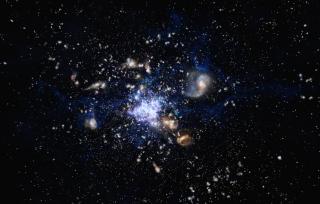Bibcode
D'Eugenio, C.; Daddi, E.; Gobat, R.; Strazzullo, V.; Lustig, P.; Delvecchio, I.; Jin, S.; Puglisi, A.; Calabró, A.; Mancini, C.; Dickinson, M.; Cimatti, A.; Onodera, M.
Bibliographical reference
The Astrophysical Journal
Advertised on:
3
2020
Journal
Citations
55
Refereed citations
48
Description
We have obtained spectroscopic confirmation with Hubble Space Telescope WFC3/G141 of a first sizeable sample of nine quiescent galaxies at 2.4 < z < 3.3. Their average near-UV/optical rest-frame spectrum is characterized by low attenuation (AV ∼ 0.6 mag) and a strong Balmer break, larger than the 4000 Å break, corresponding to a fairly young age of ∼300 Myr. This formally classifies a substantial fraction of classically selected quiescent galaxies at z ∼ 3 as post-starbursts, marking their convergence to the quenching epoch. The rapid spectral evolution with respect to z ∼ 1.5 quiescent galaxies is not matched by an increase of residual star formation, as judged from the weak detection of [O ii]λ3727 emission, pointing to a flattening of the steep increase in gas fractions previously seen from z ∼ 0 to 1.8. However, radio 3 GHz stacked emission implies either much stronger dust-obscured star formation or substantial further evolution in radio-mode AGN activity with respect to z ∼ 1.5.
Related projects

Molecular Gas and Dust in Galaxies Across Cosmic Time
Two of the most fundamental questions in astrophysics are the conversion of molecular gas into stars and how this physical process is a function of environments on all scales, ranging from planetary systems, stellar clusters, galaxies to galaxy clusters. The main goal of this internal project is to get insight into the formation and evolution of
Helmut
Dannerbauer